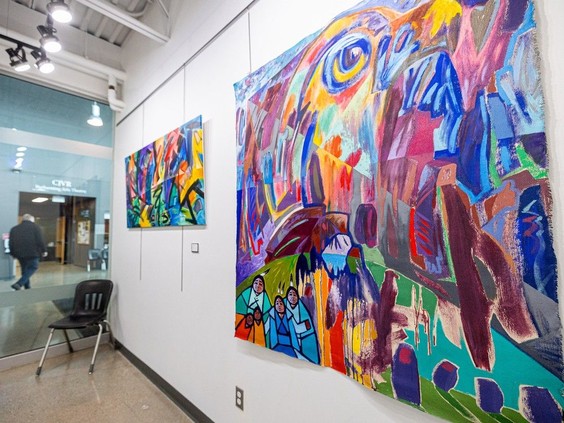
Saskatoon StarPhoenix
Editor’s Note: This story contains disturbing details and descriptions of violence and abuse some readers may find upsetting.
MELFORT — Stories about her dad were the first things Vanessa Burns told a coroner’s inquest into the 2022 mass stabbing in Saskatchewan.
“He was a funny guy,” she sobbed. “He had a sense of humour, and he worked hard and took care of us. He was a good provider. He liked hockey; we were always at a rink. He liked horses, so we were always at rodeos, too.”
Earl Burns Sr. — “Poppa,” to Vanessa’s kids — was one of 11 people killed by her ex-partner, Myles Sanderson, on Sept. 4, 2022 at James Smith Cree Nation and in nearby Weldon.
‘He would get angry and violent’
She met Myles around Christmas in 2007, she said. She was 21, and he was 17.
“In the beginning, he was charming,” she said. “Funny. He seemed normal.”
They soon became parents, though she worried they were too young. Over the years, they had five children together. They moved between JSCN and Saskatoon, and he wasn’t always around — in and out of jail, serving time for various offences.
“He would get angry and violent,” she said. “That was his way to make me stop talking.”
She remembers reporting him to police about a dozen times, but would later drop the charges “for Myles’s sake,” she said. “He instilled a lot of guilt in me. There was emotional abuse, too.”
Sometimes, when she tried to get away, the help she needed wasn’t there.
“For women who have lots of kids … you don’t want to go to a one-room shelter,” she said. “I’ve been there, and it was so crowded and lonely. I went back to Myles because there was nowhere else to go.”
Part of her also thought it would be better for the kids to have their father around because he was a good parent to them “sometimes,” she recalled. “When he wanted to be.”
She knew he was addicted to alcohol throughout their relationship, and later found out he had a cocaine addiction. In 2018, Myles was sentenced to a federal prison term; Vanessa visited him at least once a week. When he came up for parole, she spoke in support of his release.
She wrote about their plans for the future — going to a family treatment centre to encourage his sobriety and build a stronger relationship, reconnecting to their culture, supporting their kids’ love of dancing.
Reading the letter aloud at the coroner’s inquest, the rose-coloured future she painted for the parole board buckled under the weight of hindsight.
Before Sept. 4, 2022
By August 2022, there was a warrant for his arrest, but police hadn’t found him.
Around Aug. 17, he asked Vanessa — who he wasn’t supposed to contact, according to his release conditions — for a ride from Saskatoon to JSCN so he could sell cocaine.
“I thought it was kind of crazy, but I just wanted to keep the peace with him,” Vanessa said.
They spent that month travelling between Saskatoon and JSCN almost daily, picking up drugs in the city to sell them on the First Nation.
Soon, Vanessa was looking for a way out. On Sept. 2, she made her decision.
“That was the day I told him we were going home, and I was done,” she said.
In the car that night, he got angry, accusing her of flirting with another man. They exchanged blows, and Myles hit her with the sharp end of a broken drug scale and pulled her jacket over her head — all while she was driving, trying to stay on the road, she said.
“There are times when I could have rolled. Sometimes, I wish I did.”
She thought his brother Damien Sanderson — the first murder victim in the stabbing rampage — was the only person who could help her when Myles was in a rage, she testified.
That day, she took shelter in Damien’s vehicle. Myles tried to break in, but Vanessa said she remembers Damien yelling at him to stop, and Myles getting angry about Damien protecting her.
“I was praying I was going to get out of this alive,” she said.
With Damien’s help, she got her vehicle back and escaped, while her children stayed behind on the First Nation with their grandparents. When she picked the kids up the next evening, she wore heavy makeup, sunglasses and a hat to hide the bruises, she said.
She went home to Saskatoon with four of the kids; her oldest son, who especially adored his Poppa and Granny, remained on the reserve.
‘Dad tried to kill me’
That Saturday night, Vanessa slept on her couch with her keys nearby, ready to “make a run for it” if Myles barged in.
Instead, in the early hours of Sunday morning, he went on a rampage on James Smith Cree Nation.
The first thing she saw when she woke up was a message from her then 13-year-old son: “Dad tried to kill me.”
She immediately got on the phone. First her son, then her sister, told her what Myles had done. People were hurt. People were dead.
Her mom needed surgery. No one could tell her where her dad had gone. Fearing Myles would come for her next, she took the kids to Prince Albert and hid at a hotel as the provincial manhunt continued.
More than a year after he died in police custody, Vanessa said her family is working hard on healing.
“I wouldn’t say we’re doing really good, but we’re alright,” she said.
“I guess you could say my kids are relieved, because they didn’t like the domestic violence at all. It affected them. The first words my daughter said to me when her dad died is, ‘At least you won’t be getting beat up anymore.’ So we’re healing.”

